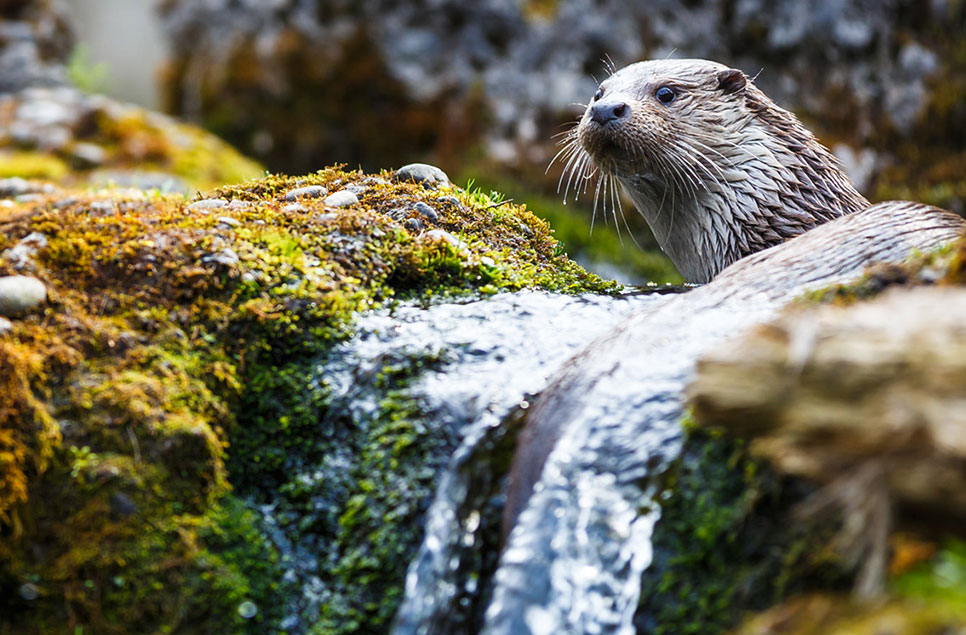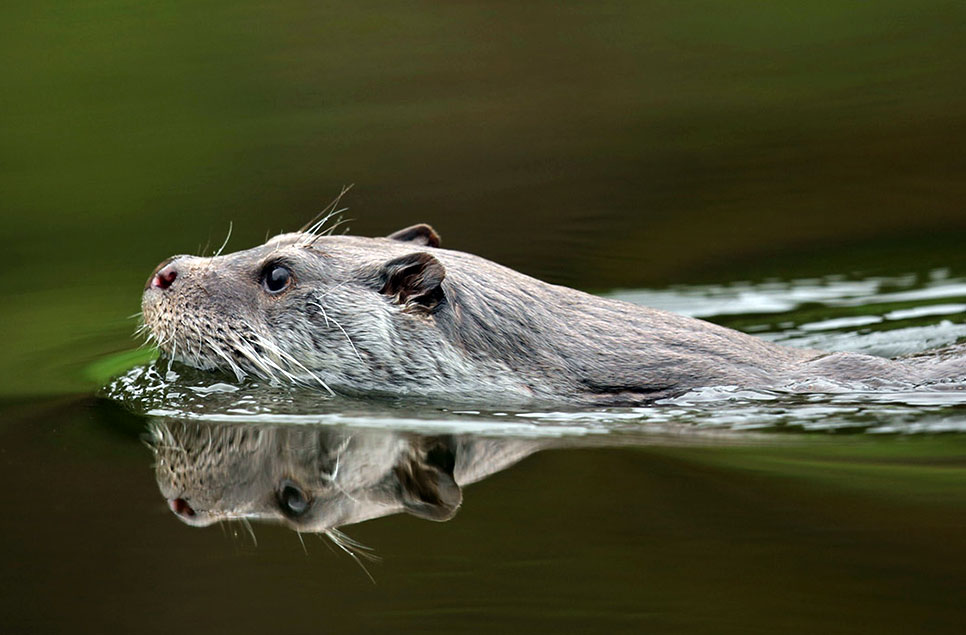Spotlight on: the European otter (and how to see them in the wild)
Otters are secretive, fascinating and adorable creatures, but why do we never see them? Find out more about otters, where otters live in the UK and what to do for the best chance of seeing them in the wild.

Ask anyone what their favourite wetland animal is and many will say it’s an otter. Beautiful, sleek and playful, otters are a joy to watch as they twist and dive in the water.
For many years our native Eurasian or European otter (scientific name Lutra Lutra) has been on the brink of extinction in the UK and spotting one in the wild would have been almost impossible, but today you are more likely to see one than at any time in the last 60 years.
Back from the brink of extinction
Eurasian otter numbers began declining in the 1950s until the species became almost extinct in England and Wales, although a small population survived in Scotland. While hunting and habitat loss played a part, pollution of our waterways from agricultural chemicals was devastating to otter populations. Thanks mainly to conservation efforts, in the early 1990s these chemicals were banned and as water quality slowly increased so did otter numbers.
Today, the Eurasian otter population is increasing (although it remains Near Threatened on the Red List) and every county in the UK now has a wild otter population.

With short limbs, webbed feet and claws the Eurasian otter is very well adapted to its watery environment. It has highly sensitive whiskers, and an acute sense of sight, smell and hearing so it can detect prey in murky waters.
Where do wild otters live, and how can you see one in the UK?
Eurasian otters are indigenous to the UK and can be found in either fresh or salt water, although it’s usually known as the river otter for the obvious reason. Because otters eat mainly fish, you’ll generally find them in areas where there are plenty of this food source. They also eat crustaceans, frogs and even small water birds. In freshwater they feed on trout and salmon. Although the Eurasian otter isn’t a marine animal (don’t confuse it with a sea otter, which are only found in the Pacific) because it can’t survive without fresh water, they are often found in coastal habitats as well as lakes, rivers and streams.
Scotland is the best place in the UK to see them and particularly on the coast, where they are generally more active during the day. Despite becoming almost extinct from England and Wales otters have managed to thrive on Scotland’s rugged coastlines and wild moorlands and today otter numbers there are thought to exceed 8,000.
The west coast of the Highlands, the Isle of Skye and the Isle of Mull are great otter strongholds, where they can be hard to miss. Author Miriam Darlington, in her book Otter Country, described the hide at Kylerhea on Skye as an ‘Otter haven’. Talk to any fisherman along the coast, and you’re likely to hear that they just saw one that morning – sometimes trying to pillage their catch! The indented coast lines, rich in seaweed and with freshwater nearby in rivers and pools make the perfect otter habitat.
See wild otters at WWT centres
At WWT we have wild otters living on all our reserves. At Slimbridge there are regular otter visitors to the Kingfisher Hide and at Washington otters have made the saline lagoon their home. They also regularly crop up on the Llanelli reserve in Wales. The presence of otters tells us a lot about the health of our wetlands, the healthier a wetland and our waterways are the more otters it will be supporting.
Distant Otter this morning on the Wear, WWT Washington
What a brute, was brilliant to watch it breach the waves.@Mammal_Society @NatureUK pic.twitter.com/MAOkF0Xs91
— David Dinsley (@NatureNorthEast) February 26, 2017
Otter causing great excitement in the entrance ditch at Slimbridge WWT this lunchtime! @slimbridge_wild @WWTSlimbridge pic.twitter.com/nJh84PUOpM
— Phil Cull (@CullyBirder) January 18, 2019
A couple of shots of the otter at WWT Llanelli @WWTLlanelli @WWTworldwide @WWTconservation @strictlysophie @wildlife_uk pic.twitter.com/9YTWHJ8RPO
— Steve Liptrot Photography (@slippy1964) January 22, 2018
What should I look for and where?
Otters aren’t the best at covering their tracks which is a great help to anyone on the lookout for one. They are creatures of habit and tend to follow the same routes, travelling as much on land as they do in water.
- Otters are noisy creatures and you might well hear them before you see them. Keep an ear out for scrabbling, splashing and squeaking.
- Look for a muddy, semi-circular slide into the river.
- Otters have five claws so it’s easy to tell an otter footprint from most other animals. The invasive American mink also has five toes, but the pads are much narrower and the claws more pointed.
- Otter droppings, or spraints, are often used to mark territory – look for them along the river bank or on rocks. They are a greeny black colour and are often described as smelling like flowers!
The 10 best places to look for otters and their signs
Even though there are more of them about otters are still hard to spot. They are fast, naturally secretive and usually nocturnal. Otters feed at dawn and dusk so the two hours before are generally the best time for otter spotting. They breed all year round, but in the UK otters tend to have their young (called pups) in the summer months so at this time of year, you stand a better chance of glimpsing a sight of them in rivers and coastal wetlands. Keep an eye out for them:
- Under and near bridges
- On banksides
- On boulders or rocks either in river or near the river
- On old tree stumps or logs
- At either end of shortcut paths
- On gravel banks
- In sand and muddy areas
- Around ponds and lakes
- In marshes or reed beds
- At river junctions or intersections
Eurasian otters face new risks
Today an otter’s main threat is from what we put in the water. More and more traces of drugs and medicines, and the plastic pellets found in exfoliants, are being found in rivers, and they’re also being found in otters’ bodies.
For coastal dwelling otters, oil spill is a real danger. The Minch waters between Skye and the Outer Hebrides, where many otters live, is still a major tanker route. Otters are thought to be especially vulnerable to the effects of oil. There are many reasons for this, including their small size, a high metabolic rate, a complete reliance on their fur for thermal isolation and long periods spent floating in the water where oil has collected.
And if you want to guarantee seeing an otter…
If you don’t see one, you can always visit Martin Mere or London Wetland Centre to see some of our resident Asian-short clawed, or Slimbridge to see our North American river otters (they’re not nocturnal, so you’re more likely to get a glimpse.)
Otter facts
- A group of river otters is known as a romp
- The position of its eyes are high on its head which means it can see out of the water whilst the rest of its body stays submerged below - like a hippo!
- Otters communicate using their spraint (droppings). Over 100 different components have been identified within otter droppings and some of these are thought to contain information on sex, age and even individual recognition which can be used by other otters
- All otters basically have two layers of fur - a longer outer layer and a softer denser layer underneath. This soft layer closest to their skin traps air, which gives good insulation. The longer outer layer of guard hairs is waterproof, and stops water touching their skin at all, which means they don't lose heat that way either from the water leaching away precious body warmth
- When it’s underwater the otter can close its ears and nose but can only hold its breath for about 30 seconds



